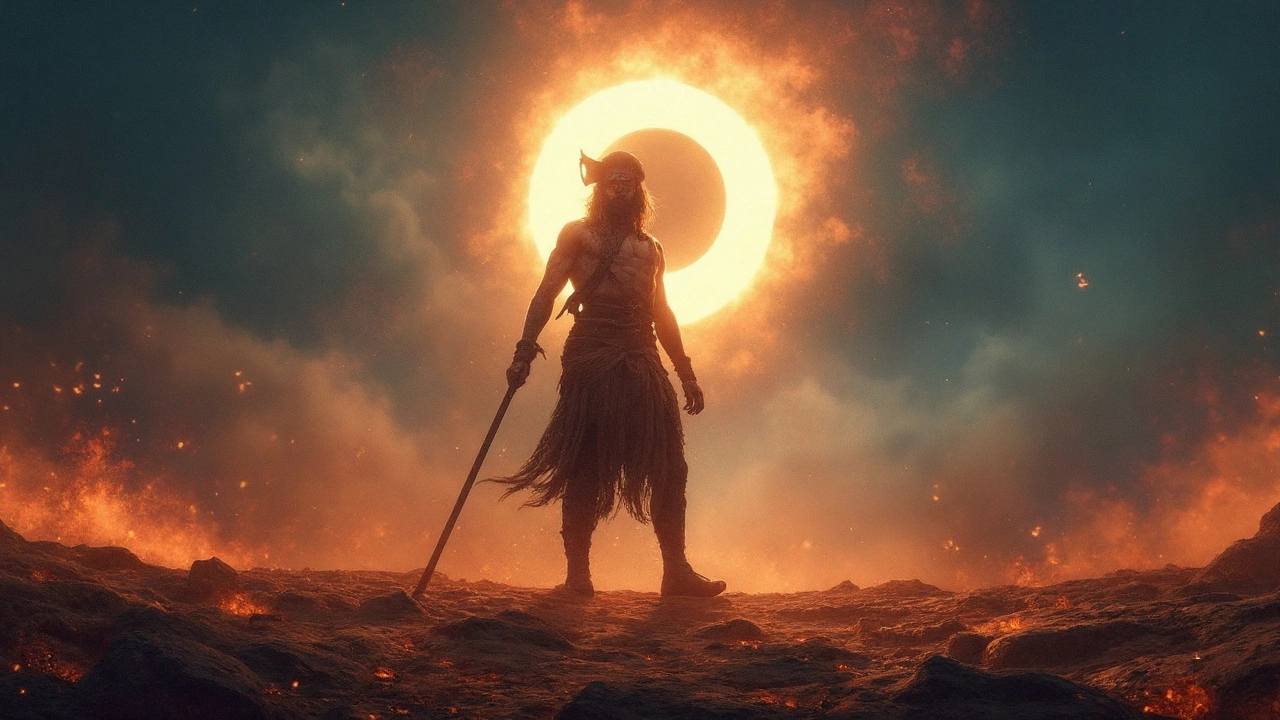A mythological thriller scaled for today
Myth and modernity rarely meet this bluntly on the big screen. Mirai opens with the weight of history—Emperor Ashoka, a war-scarred ruler, placing nine divine powers into nine sacred texts—and swings hard into a present-day hunt for those very scriptures. It is unashamedly pulpy, lush to look at, and loud in all the right places. If you came here for a straight hero-villain chase, you’ll get it. If you came for a mythic clash between Dharma and Adharma, you’ll get that too. This Mirai movie review looks at how those two tracks line up.
Directed by Karthik Gattamneni, the 169-minute film spreads its story across centuries but keeps its stakes very clear. Ashoka’s nine scriptures are scattered among nine warrior lineages. Cut to the year 2000. A shadowy force—Mahabir Lama, nicknamed The Black Sword—starts gathering the texts one by one, aiming for immortality and dominion. Between the legend and the looming threat sits Vedha Prajapathi, a young man from Hyderabad who doesn’t know his role in any of this—until he does.
Teja Sajja’s Vedha is introduced as a free spirit: streetwise, charming, and more worried about the next good day than the next great quest. The first half plays to that beat—lighter scenes, flashes of humor, and a warm, lived-in Hyderabad. But the tone sharpens once Vedha’s link to the scriptures is revealed. The film shifts gears without abandoning its core: a good man finding resolve, not because the plot needs it, but because his values do.
What gives Mirai its muscle is the way it pulls the canvas wider. The script doesn’t just nod to mythology; it roots its conflicts there. The film invokes Lord Rama and reaches toward Treta Yug, the age where the idea of duty itself was forged in fire. There’s a striking stretch where devotion and combat stand side by side, and a finale that leans on Sanskrit shlokas to frame the showdown. It’s not subtle, but it is sincere, and that sincerity holds the big moments together.
That said, the film isn’t a lecture dressed as a blockbuster. It’s a chase, a puzzle, and a power struggle. Are the nine books as almighty as everyone believes? What exactly is Mirai—a volume, a vault, a symbol? The script keeps the mystery alive without playing cheap. The reveals land in a way that respects the set-up: if these texts hold power, they also demand responsibility. And if people kill to control them, that tells you something about human hunger more than divine design.
Mirai is also careful about balance. It respects mythology without letting it turn the film into a museum exhibit. The world-building borrows the texture of epics—rituals, relics, coded lineages—yet it sits inside a contemporary thriller skeleton. That mix avoids sermons and chases the universal: what do people do when they think they’ve found a shortcut to greatness? Who are we, when history’s secrets step into the present?
Performances, craft, and the larger trend
Teja Sajja carries the film with a steady hand. Coming off a breakout where he proved he could headline a homegrown fantasy-action setup, he plays Vedha as two halves that fit: a breezy youngster who can blend into a crowd and a driven protector who can stand alone. The transformation isn’t a switch; it’s a burn that gets hotter scene by scene. In the second half, when belief and action need to fuse, he finds a quiet intensity that anchors the film.
Manchu Manoj is the counterweight. As Mahabir Lama, he doesn’t overcomplicate the villain. He gives him purpose, posture, and presence. The eyes do a lot of work, the baritone fills gaps the script leaves, and the physicality makes the threat feel immediate. There’s no winking at the camera, no coyness about motives. Power is the point; fear is the method. When the hero finally meets him on equal terms, you feel the film tighten.
Shriya Saran gets more room than her casting teasers suggested, and she uses it. As Ambica, she sits at the crossroads of guilt and love, and the film lets that play out rather than rushing past it. She is not there just to pass along a relic or a prophecy. Her choices mark the cost of this world—what devotion demands, what sacrifice looks like. It’s a cameo that matters to the spine of the story, not just the surface.
Ritika Nayak’s Vibha is the moral compass who doesn’t raise her voice to be heard. She gives the narrative a steady line to follow, the kind of character who listens before she judges and still finds courage when the plot turns rough. Jayaram adds weight in support, grounding scenes that might otherwise tip into noise. Together, the ensemble does what a myth-thriller needs: it builds a world that feels inhabited, not staged.
On the craft side, Mirai is ambitious and mostly in control. The camera loves scale—temples and courtyards, torch-lit corridors, outdoor vistas that suggest miles of story outside the frame. Action design favors clean geography over shaky chaos, so you can track the stakes inside a fight, not just the sparks flying out of it. The visual effects back the vision rather than bullying it; they don’t announce themselves every minute, but they hold up in the heavy lifts.
The score is tuned to the film’s dual language: devotional when belief is the engine, propulsive when the hunt is on. Percussion drives the chases; choral layers fill the ritual beats. You can feel the music doing a job—bridging eras and moods—and the sound mix keeps dialogue intelligible even when the drums go hard. It’s the kind of track that will play well in theatres, where bass can double as heartbeat.
The screenplay is disciplined in setup and vivid in payoff, but it does stretch the clock. At 169 minutes, you notice the length, especially in the midsection where exposition crowds momentum. The film isn’t dull; it’s just busy. A tighter pass could have shaved minutes without losing meaning. Still, when the third act calls for scale and spirit, the groundwork pays off.
Beyond the plot, Mirai sits inside a clear wave in Indian mainstream cinema: faith-coded adventure built with modern genre tools. You can see that shift in how filmmakers stitch folklore to thriller rhythms and scale up with VFX and world-building. The tightrope is thin—go overboard and you risk kitsch; go timid and you undercut the awe. Mirai stays on the wire by betting on emotion first, spectacle second. That choice keeps its big mythic swings from feeling like mere decoration.
The film is also careful with portrayal. It invokes Lord Rama and the Ramayana with reverence, not as props. When the narrative crosses into Treta Yug, it uses the shift to debate duty rather than to chase nostalgia alone. The Sanskrit-heavy finale could have turned opaque, but the staging makes the moral beats legible even if you don’t catch every word. The point is clear: strength without purpose is just force; strength with faith is something else.
As a theatrical experience, Mirai knows its audience. Families will find a clean moral line. Younger viewers get a sleek action-fantasy with lore. Devotional viewers get respectful treatment. Genre fans get a villain who means business and a hero who earns his stripes. It’s engineered for the big screen—wide frames, big sound, a climax that feels like a curtain call.
Where the film nudges beyond a one-and-done is the final tease. A post-credits breadcrumb hints at future chapters, suggesting that this isn’t just a one-off fable but the pilot of a wider myth-verse. That has production logic—repeatable relics, scattered lineages, villains with agendas—but it also fits the story’s ethos. If power hides in nine places, stories can too. Each can stand alone and still click into a larger puzzle.
Does Mirai answer every question it raises? Not quite, by design. It leaves threads it intends to pull later. But it resolves the big ones it owes you in this chapter: what Mirai is and what it is not, what belief can do in the face of brute hunger, and who Vedha becomes once his path is no longer a secret. The central mystery serves the character, not the other way around.
For viewers weighing that 169-minute sit, here’s the balance sheet in plain terms.
- What lands: Teja Sajja’s steady lead; Manchu Manoj’s forceful antagonist; the Ramayana-laced second half; a finale that marries shlokas with scale; a score that punches above its weight; production design that feels lived-in.
- What drags: a mid-act stretch where lore repeats; a few detours that explain what the images already show; a runtime that tests patience before the payoff.
None of those dips undo the film’s core intent—to fuse an old moral frame with a new cinematic engine. You walk out with images that stick: a weapon raised not out of rage but duty, a scripture that is more burden than boon, and a hero who looks smaller than the legend but stands taller than the threat. That’s the balance Mirai is after.
As myth-driven Indian cinema keeps evolving, Mirai is a marker for what works when belief meets craft. It argues that reverence and momentum can share the same frame. It pushes for faith not as a shortcut to power, but as a check on it. And it leaves the door ajar for more—more relics, more trials, more reckonings—if this world returns for another chapter.





